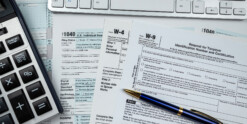I’m a committed advocate of income investing — of buying assets that throw off income that can be reinvested while you are growing your nest egg, then used to help meet your expenses in retirement. Dividend-paying stocks are a significant source of such income.
Let’s talk about dividends — what they are, how they work and why I’m such a fan.
Imagine this: You want to fill a bucket from a faucet. Now, this faucet works, but slowly. You know it only drips water, so it’s going to take a long time. Still, in the morning, you put your bucket under the faucet, turn it on and let it drip, drop by drop, and then go about your day. When you return in the evening, the bucket is full of water.
This is the power of dividends.
We all want our money to grow. There is a simple formula for this: Total Return = Growth + Income. We can reasonably expect the equity markets to increase in value over the long term, with ups and downs during individual years. But that’s only half of our equation.
The other half has to do with that steady stream (or drip) of cash dividends.
Regular dividends are paid out of a company’s profits to shareholders — i.e., the owners of the business. There are two types of dividends — those from preferred stocks and those from common stocks.
For a company that has preferred stock issued, they must make their dividend payments before even a penny can be paid out to the common stockholders. The preferred stock dividend is typically set, whereas the common stock dividend is decided by the board of directors.
In addition to these regular dividends, there are some instances when a company may pay a special one-time dividend. Such payments are rare and typically occur because of some big event, like a major litigation win, the sale of a business, or liquidation of an investment. Because of the preferential taxation on most dividends since tax law changes in 2003, there has been a significant amount of special (or one-time) dividends paid out over the past 15 years.
A key point to remember is dividends are highly dependent upon actual cash flow, versus reported earnings, which can be modified or sculpted in a variety of ways. Nearly any board of directors would like to continue to pay a regular dividend if the company’s cash flow is strong, even if they might report an “earnings loss” for a given quarter. The reason is simple: Investors that own dividend-paying stocks want consistency.
If a company decides to lower its dividend, it will likely experience a decline in stock price as leery investors decide to take their money elsewhere in search of more consistency. The flipside here is that companies don’t typically raise dividends simply because they’ve had one good year. Instead, businesses tend to wait until they build a track record of success before they raise dividends. This, again, has to do with consistency. Companies want to be sure they are capable of maintaining these higher dividend payments for years to come.
Dividend Amount vs. Dividend Percentage Yield: A stock’s dividend yield is simply the annual dividend paid divided by the share price. In a given year, dividend amounts tend to stay very steady, even if a company’s stock price may experience significant fluctuation. This relationship helps when a dividend-paying stock’s price falls. Why? Because as long as the dividend amount stays the same, or is “safe,” the percentage dividend yield of that stock will increase. This relationship of lower stock price and higher yield can help buffer stock prices’ losses. A stock’s percentage dividend yield will tend to go up as the price heads lower. This relationship entices new investors to buy a larger “cash flow stream” due to the reduced price, which over time drives the percentage dividend yield back down.
Southern Company offers an illustration of this. The behemoth electric utility company has paid dividends for decades and has always shied away from reducing its dividends. If Southern Company’s stock price falls, its percentage dividend yield goes up, and tends to attract new investors.
To close our discussion, let’s dissect why dividends can be a healthy addition to an investor’s portfolio.
Dividend reinvestment can substantially increase in value over the long haul. Consider an example:
Say you had put $10,000 in an S&P 500 stock index fund at the end of 1985. If you had not reinvested your dividends, you would have ended up with $29,150 at the end of 1995 — a decade later. Now, assume that you had reinvested those dividends. Your initial $10,000 portfolio (assuming you didn’t add any more cash to it) would be north of $40,000.
Using this example, reinvesting those seemingly small dividends would have resulted in more than $10,850 over just 10 years. Now, if you had continued to add money to your principal investment and held on for three or four decades, the difference could be hundreds of thousands of dollars more.
Drip by drip, the bucket becomes full.
The original AJC article appears here.
DISCLOSURE
This information is provided to you as a resource for educational purposes only and should not be considered investment advice or recommendation or an endorsement of any particular security. Investing involves risk, including the possible loss of principal. There is no guarantee offered that investment return, yield or performance will be achieved. There will be periods of performance fluctuations, including periods of negative returns. Past performance is not indicative of future results when considering any investment vehicle. The mention of any specific security should not be inferred as having been successful or responsible for any investor achieving their investment goals. Additionally, the mention of any specific security is not to infer investment success of the security or of any portfolio. A reader may request a list of all recommendations made by Capital Investment Advisors within the immediately preceding period of one year upon written request to Capital Investment Advisors. It is not known whether any investor holding the mentioned securities have achieved their investment goals or experienced appreciation of their portfolio. This information is being presented without consideration of the investment objectives, risk tolerance, or financial circumstances of any specific investor and might not be suitable for all investors. This information is not intended to, and should not, form a primary basis for any investment decision that you may make. Always consult your own legal, tax, or investment advisor before making any investment/tax/estate/financial planning considerations or decisions.













